Borra Caves
Borrā Guhalu | |
|---|---|
 | |
.svg.png.webp) Borra Caves Location in Andhra Pradesh, India | |
| Coordinates: 18°10′N 83°0′E / 18.167°N 83.000°E | |
| Country | India |
| State | Andhra Pradesh |
| District | Alluri Sitharama Raju |
| Area | |
| • Land | 0.8 sq mi (2 km2) |
| Elevation | 2,313 ft (705 m) |
| Time zone | UTC+5:30 (IST) |
| Located in Borra village in the Ananthagiri hills of Eastern Ghats | |
The Borra Caves (Borrā Guhalu) are located on the East Coast of India, in the Ananthagiri hills of the Araku Valley (with hill ranges' elevation varying from 800 to 1,300 m (2,600 to 4,300 ft)) of the Alluri Sitharama Raju district in Andhra Pradesh. The caves, one of the largest in the country, at an elevation of about 705 m (2,313 ft), distinctly exhibit a variety of speleothems ranging in size and irregularly shaped stalactites and stalagmites.[1][2] The caves are basically karstic limestone structures extending to a depth of 80 m (260 ft), and are considered the deepest caves in India.[3][4] The native name for the caves is Borrā Guhalu where Borra means abdomen in and Guhalu means caves in Telugu language.
Etymology
Borra is Telugu word in native North Andhra dialect which means hole('Boriya' in standard Telugu).[5]
Legend
On the discovery of the caves, there are several legends, which the tribals (Jatapu, Porja, Kondadora, Nookadora, valmiki etc.[4]) who inhabit the villages around the caves narrate. The popular legend is that a cow, grazing on the top of the caves, dropped 60 m (200 ft) through a hole in the roof. The cowherd while searching for the cow came across the caves. He found a stone inside the cave that resembled a Lingam, which he interpreted as the Lord Shiva who protected the cow. The village folk who heard the story believed it and since then they have built a small temple for Lord Shiva outside the cave. People flock to the temple for worship and the cave to get a glimpse of the Lingam.[6]
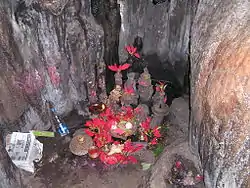
Another lyrical legend is that the Shiva Lingam representing the Hindu God Lord Shiva, is found deep in the caves and above which is a stone formation of a cow (Sanskrit: Kamadhenu). It is surmised that the udder of this cow is the source of the Gosthani (Sanskrit: Cow's udder) River which originates from here, flows through Vizianagram and Visakhapatnam districts before emptying into the Bay of Bengal near Bheemunipatnam.[6]

Geography and climate
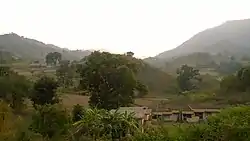
The caves are located in the Araku Valley of the Ananthagiri hill range and is drained by the Gosthani River. At the entry, the cave measures up to 100 m (330 ft) horizontally and 75 m (246 ft) vertically. Stalagmite and stalactite formations are found in the caves.[7]
The average annual temperature of Araku hills, where the caves are situated, is about 25 °C (77 °F). The average annual rainfall reported is 950 mm (3.12 ft) (mostly occurring during the northeast monsoon).[8] The Gosthani river provides water supply to the Visakhapatnam city.[4]
Geology
The regional geology in the Eastern Ghats mobile belt, where the caves are located, is represented by the khondalite suite of rocks (garnetiferous sillimanite gneisses, quartzo-feldsphatic garnet gneisses) of Archaen age. Quaternary deposits consist of red bed sediments, laterites, pediment fans, colluvium, alluvium and coastal sands.[1] The caves in the reserved forest area basically host a variety of speleothems of various sizes and irregularly shaped stalactites and stalagmites. The carbonate rocks are pure white, and coarsely crystalline and the deformed and banded marbles cover a triangular area of two km2 (0.77 sq mi); surrounded by diopside–scapolite–feldspar calc-granulites. The pyroxenite outcrops are dark and massive and include discontinuous calc-silicate bands, some of brown mica and others with calcite.[8]
Formation
The Gosthani River, which originates from these caves and flows between the solidified stalactites and stalagmites in the karstic limestones formation, is the cause for the development of the odd shapes of structures. Water percolating from the roof of the caves dissolve limestone and trickle drop by drop to form stalactites at the roof of the cave and then dripping down to the ground form stalagmites. These deposits have developed into interesting forms and structures inside the caves such as Shiva–Parvati, Mother–Child, Rishi's beard, human brain, mushrooms, crocodile, temple, church, etc. These shapes have captured the imagination of tourists, while some have been given religious interpretations.[8][9]
Formations in the caves
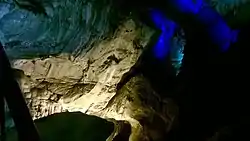

The caves are deep and totally aphotic. There is an area in the caves with limited light penetration. The stalactites seen in the caves are about 0.1 to 3.5 m (0.3 to 11.5 ft) in length while the stalagmites are 1.2 m (3.9 ft) long and columns are 6 m (20 ft) in height and 0.75 m (2.5 ft) in width. The height of the cave is 12 m (39 ft) and the length is about 200 m (660 ft). The average temperature of the inner cave wall is reported to be about 16 °C (61 °F). Sulfur springs discharge into the cave passages causing corrosion of limestone. The spring waters display floating mucus-like biofilms.
These are thick orange microbial mats (2.5 to 3 cm [1.0 to 1.2 in] thick) with patches of yellow biofilms extending 3 m (9.8 ft) from the aphotic deep cave orifice.[8]
While the caves are basically limestone formations, the area surrounding these are of mica formations which are prospected for precious stones like rubies.[7]
Archeological artifacts (Paleolithic implements) have been found in the caves.[10] The excavations carried out in the caves by the archeologists of the Andhra University, have unearthed stone tools of middle Paleolithic culture dating back 30,000 to 50,000 years, which confirm human habitation.[4]
Genesis
Speleothem carbonates found in the caves have been subject to scientific studies. In fluviatile, spring, cave and soil environments microbial carbonates are important. In the biofilms and/or microbial mats, which are formed in the caves, the principal organisms associated are bacteria, particularly cyanobacteria, small algae and fungi. Petrographic analysis of a thin section has uncovered the presence of lithified structures and micrite, present as laminated to clotted with chocolate-brown blebs. These are identical to microbialites observed in modern and ancient stromatolitic carbonates. Laboratory observations with scanning electron microscope (SEM) have also confirmed the presence of calcified bacteria, micro-rods, and needle calcite. Organic mats (yellow-orange in colour) are made up of mineralized filamentous bacteria, bacterial stalks, cells and sheaths. Thus, these studies have indicated that microorganisms have actively influenced the genesis of speleothems of the Borra Caves.[8]
Biological environment
Micro organisms
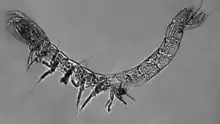
The effect of microorganisms in the mats on the cave formation and their role on iron mineral precipitation has been further studied. A report indicates a link between iron–rich mats formation and iron precipitating bacteria.[11]
Fauna and flora

The fauna observed in the caves are predominantly bats, as well as the golden gecko. The type of bat reported is the fulvous fruit bat (Rousettus leschenaultii) – a species which roosts in large caves, old buildings, dungeons and dark areas of old forts. This species has short and slender musculature with large, well developed eyes. They feed on flowers and fruits, particularly jamun, guava, silk, cotton and mango.[8][10][12]
Stygofauna
Habrobathynella borraensis was described from the Borra Caves. It is the first Indian cavernicolous species of the genus Habrobathynella.[13]
Location and access

The caves are located in the Ananthagiri hills range of the Araku valley of the Alluri Sitharama Raju district in Andhra Pradesh. The caves are 448 kilometres (278 mi) from Bhubaneshwar in Odisha and 656 kilometres (408 mi) from Hyderabad, both via National Highway 5. The caves are well connected by road, rail and air services. The nearest international airport is Visakhapatnam Airport, 76 km (47 mi) from Borra Caves, which is 12 kilometres (7.5 mi) from the Visakhapatnam city center. Vishkapatnam is 90 km (56 mi) away by road. It is mostly a hill road and the journey takes about three hours.[7]
Train services operate on the Kothavalasa-Kirandul railway line in East Coast Railway, Indian Railways. The train journey over a distance of 100 km (62 mi) from the Vishkapatanam railway station passes through Eastern Ghats (hill) section), which has 30 tunnels en route. The journey by train takes about five hours to the Railway Station near the caves called the Borra Guhalu Railway station.[6]
Visitor information

Guided tours for a day trip to the Borra Caves cover interesting attractions like the Tyada Railway Tunnel, Damuku View Point, Ananthagiri Coffee Plantation, Padmapuram Gardens and the Araku Valley. For the benefit of the visitors, an information board at the entry point to the caves gives some details of the caves and its surroundings (pictured).[4][9] An Arraku and Borra rail-cum-road package tour organized by the Andhra Pradesh State Tourism Department is available for visitors keen to see the Borra Caves.[14] A walk around the caves provides views of the mountainous area which is rich in flora and fauna. The Andhra Pradesh State Tourism Department has installed 26 mercury, sodium vapor and halogen electric lamps, which provide views of the formations. The Araku valley, a hill station about 29 km (18 mi) from the Borra Caves, is also a tourist attraction for people visiting the caves.[7][9]
November and December are ideal months to visit the caves.[7]





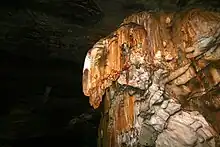

See also
References
- 1 2 "Astrobiology & Geomicrobiology". Division Microbial Systems Ecology, Department of Microbiology, Technische Universität München, Germany. Archived from the original on 13 May 2008. Retrieved 14 February 2009.
- ↑ Barry F. Beck; Adrianne Hagen (1 January 1989). Engineering and Environmental Impacts of Sinkholes and Karst. Florida Sinkhole Research. Taylor & Francis. p. 392. ISBN 978-90-6191-987-2. Retrieved 14 February 2009.
- 1 2 3 4 5 File:Borra Caves Info board.JPG
- ↑ "borra meaning in Telugu". Retrieved 1 June 2023.
- 1 2 3 "Borra Caves". WWW showcaves. Retrieved 14 February 2009.
- 1 2 3 4 5 "Borra Caves, Eco India". Retrieved 14 February 2009.
- 1 2 3 4 5 6 "Evidences for microbial involvement in the genesis of speleothem carbonates, Borra Caves, Visakhapatnam, India by Sushmitha Baskar, R. Baskar and Anubha Kaushik" (PDF). Current Science Journal, Vol 92, No.3. 10 February 2007. Retrieved 14 February 2009.
- 1 2 3 "Borra Caves – A Million-Year old Wonder". Archived from the original on 13 November 2008. Retrieved 14 February 2008.
- 1 2 Virginia H. Dale; Richard A. Haeuber (2001). Applying Ecological Principles to Land Management. Springer. pp. 103, 346. ISBN 978-0-387-95100-3. Retrieved 14 February 2009.
- ↑ Baskar, Sushmitha; et al. (4 December 2007). "Precipitation of iron in microbial mats of the spring waters of Borra Caves, Visakhapatnam, India: some geomicrobiological aspects". Environmental Geology. Spring Link, Springer Berlin, Environmental Geology. 56 (2): 237–243. doi:10.1007/s00254-007-1159-y. S2CID 128814523.
- ↑ "Biodiversity News of Andhra Pradesh, Volume 2, Issue 1, Fruit Bats of Andhra Pradesh, page 4" (PDF). April–June 2008. Archived from the original (PDF) on 25 February 2009. Retrieved 14 February 2009.
- ↑ Reddy, Yenumula Ranga; Shaik, Shabuddin; Totakura, Venkateswara Rao (1 January 2014). "Habrobathynella borraensis n. sp. (Syncarida: Bathynellacea: Parabathynellidae) from the Borra Caves of southeastern India, with a note on the taxonomic significance of paragnath morphology". Journal of Crustacean Biology. 34 (1): 90–106. doi:10.1163/1937240X-00002210. ISSN 0278-0372.
- ↑ "Valley of enchantment". Archived from the original on 10 September 2009. Retrieved 14 February 2009.
{{cite web}}: CS1 maint: unfit URL (link)
- Ramesh Y (1990). Geomorphic Studies in Upper Gostani River Basin with Special References to Borra (Karst) Caves Visakhapatnam District, A.P., India, India.
- Le Bas, M.J., Subbarao, K.V. and Walsh, J.W. Metacarbonatite or marble? – the case of the carbonate, pyroxenite, calcite-apatite rock complex at Borra, Eastern Ghats, India, Journal of Asian Earth Sciences, 20, 2002, 127–140.